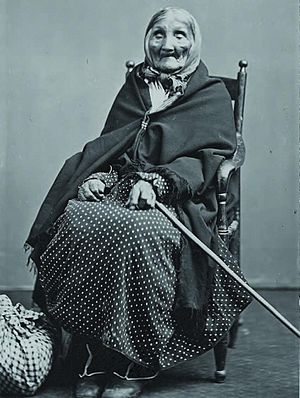Dinah John facts for kids
Dinah Anthony John, sometimes called Aunt Dinah, was a respected member of the Onondaga people in New York. She lived a very long life, from about 1774 to 1883. Dinah was known for her old age and her good relationships with both her tribe and the American settlers nearby. When she passed away in 1883, people said she was 107 years old. This made her the oldest known Native American at that time.
Contents
Her Early Life
We don't know the exact year Dinah Anthony was born. But in 1892, a writer named Thomas Donaldson said she was 107 when she died. Another historian, William Martin Beauchamp, thought she was born around 1774. Beauchamp also wrote that Dinah saw George Washington and knew Horatio Seymour when he was a baby.
Many Onondaga people left central New York after American soldiers attacked their villages. But Dinah John stayed. In 1806, there were only 143 Onondaga people on the Onondaga Reservation. By the time she died, that number had grown to about 500. Dinah also saw a huge increase in the number of white settlers in the area.
Historians think Dinah might have married in the late 1700s or early 1800s. She was living with Thomas John by 1811.
A Life of Service and Craft
During the War of 1812, the Onondaga people fought alongside the United States against the British. Dinah John and her husband served in Native American groups. Dinah worked as a cook. She was one of at least 14 Native American women who helped in this way. A book from the National Museum of the American Indian suggests that these women likely did much more than just cook during the war. Dinah Anthony and Thomas John were reportedly married around 1816.
After the war, Dinah and Thomas moved to a house on the reservation. They farmed the land around their home. They had at least two children. Dinah made and sold things like baskets and pots to white customers in nearby Syracuse, New York. She would walk between the reservation and the city almost every day until she was over ninety years old.
The local white people thought very highly of her. This was partly because she was so old and had a connection to the American Revolution. They knew her as "Aunt Dinah." Even so, she always stayed true to her own culture. She did not promise loyalty to the United States and kept speaking the Onondaga language.
Later Years and Legacy
Because Dinah's husband, Thomas, had served in the War of 1812, he could get a special payment called a pension. If he died, this money would go to his wife. Thomas passed away around April 1857. Four months later, Dinah John asked for a widow's pension. She hired a white lawyer to help her, but her request was turned down the next year.
In 1871, a new law changed how pensions were given to war veterans. Dinah tried again to get a pension. She hired another white lawyer for help. But her request was rejected again. It was hard for her to prove her marriage because no witnesses were still alive by 1871. An agent was sent to look into her request and suggested it be denied.
In 1876, a photographer named Philip S. Ryder took a picture of Dinah. This photo was shared widely across central New York. A report from that time said she was 100 years old when the picture was taken.
As Dinah got older, in the 1870s and 1880s, she became weak and didn't have much money. Finally, in 1882, the 1871 pension law was changed again, and she received her pension. A story about "famous people who lived to be 100" was published later that year. It said that when Dinah was told she would get her pension, she laughed and said she was "too old now."
She lived only one more year, passing away on the Native American reservation on May 26, 1883. On July 7, citizens from Syracuse put up a 5-foot tall tombstone in her memory. When she died, people thought she was between 99 and 109 years old. It was commonly reported that she had lived to be 107. A death notice in The Boston Globe said she was the oldest Native American when she died. Frank Leslie's Illustrated Newspaper also reported this.
What People Remembered About Her
Arthur C. Parker estimated that only 15 Native American women from New York helped in the War of 1812, mostly as cooks. Four of them received pensions for their service. However, Dinah John had trouble proving her service, even though some sources say she was one of the Iroquois women who did get a pension. Her story was included in a 1911 book called The Art of Longevity. This book suggested that her long life was partly because she spent a lot of time outdoors.
The American historian Laurence M. Hauptman wrote that Dinah John was "among the most important Iroquois women of the nineteenth century in New York." He described her as a "leading Onondaga basketmaker and potter." He also noted that she was one of the first Iroquois women to have her portrait taken. Beauchamp said she was "for many years, one of the best known women in the county."


